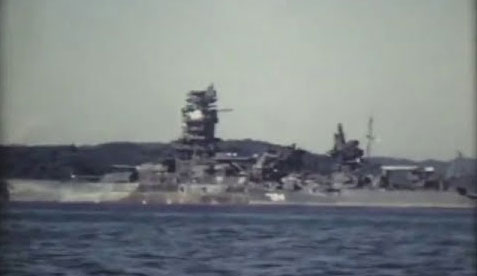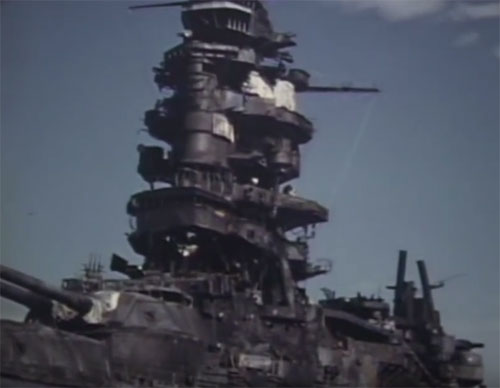
My initial sight of the massive hill and pagoda of the ex-IJN Nagato had come after arriving at Yokosuka by sea-plane. My next sight of her came as an incident of a scheduled air-voyage to Hokkaido.
We were weather bound a day in port, as nothing was flying to get us to the inspection sites up north. Fascinated by the big ship, I asked how I might get aboard for a tour. I was informed that visitors were not permitted on the Nagato, but after hooking a ride on a passing Mike boat, I found no resistance was actually offered at the gangway.
If I had known to look, I might have seen a signal flag run up from the flag bag on the pagoda to signal that an unknown officer was coming aboard, and any unscheduled non-regulation activities should be suspended immediately.

Nothing was quite what it seemed on the battleship, and I found that an un-conducted tour of the ship was depressing, since it reflected the filth, destruction, confusion and all the drabness of war. The thrill of treading the deck of a Japanese Battleship lasted but a moment.
After a brief inspection, I was ready to go back ashore, and was intensely annoyed when I could not get a boat. As I paced off my bad humor on the forecastle, I was respectfully joined by a little Japanese fellow in curious black leather, split-toed shoes called “tabis.” These were a type of unique outdoor footwear which had been worn by construction workers, farmers, painters, road workers, rickshaw pullers and others since the late Meiji Period in Japan.

The most distinctive characteristic of tabi shoes is the split-toe design that separates the big toe from the other toes. This feature enhances their comfort and stability, important qualities in a shipboard environment. The sole of traditional Tabi shoes are made of pliable natural rubber which is soft enough to be flexible, but stiff enough to protect the wearer’s foot from ground debris.
The little fellow wore a frayed mustard-colored uniform with a matching cap with a short brim, almost like Japanese military fatigues. His face was nearly toothless and his skin was as gray as a mouse.
In a mixture of Spanish, Portuguese and Italian he related who he was. He gestured as he said his name was Matano, and that he was an electrical engineer who had graduated from the University of Sao Paulo, and had practiced his profession twenty years in Brazil. Returning to Japan for a visit in the fall of 1941, he had been caught in the toils of the war.
Strange phenomena and tales of harrowing adventure were no longer a novelty to me; I listened to his tales of bomb-dodging not out of interest but from sheer boredom as I scanned the harbor for a boat to hail and return ashore. If I had thought about him at all, it was to tick him off subconsciously as one of the resident ghosts of the massive haunted warship. But I was to think much of him, and his formidable skills, later on in a desperate dark night far from shore.
And to be intensely thankful I had made his acquaintance that foul day at the anchorage in the Sagami-wan. At that point, I had no idea I was to be the Executive Officer of this ghost ship, or custodian of the well-being of the merry pirates who would take her on her last voyage.
Copyright 2015 Vic Socotra
www.vicsocotra.com
Twitter: @jayare303
